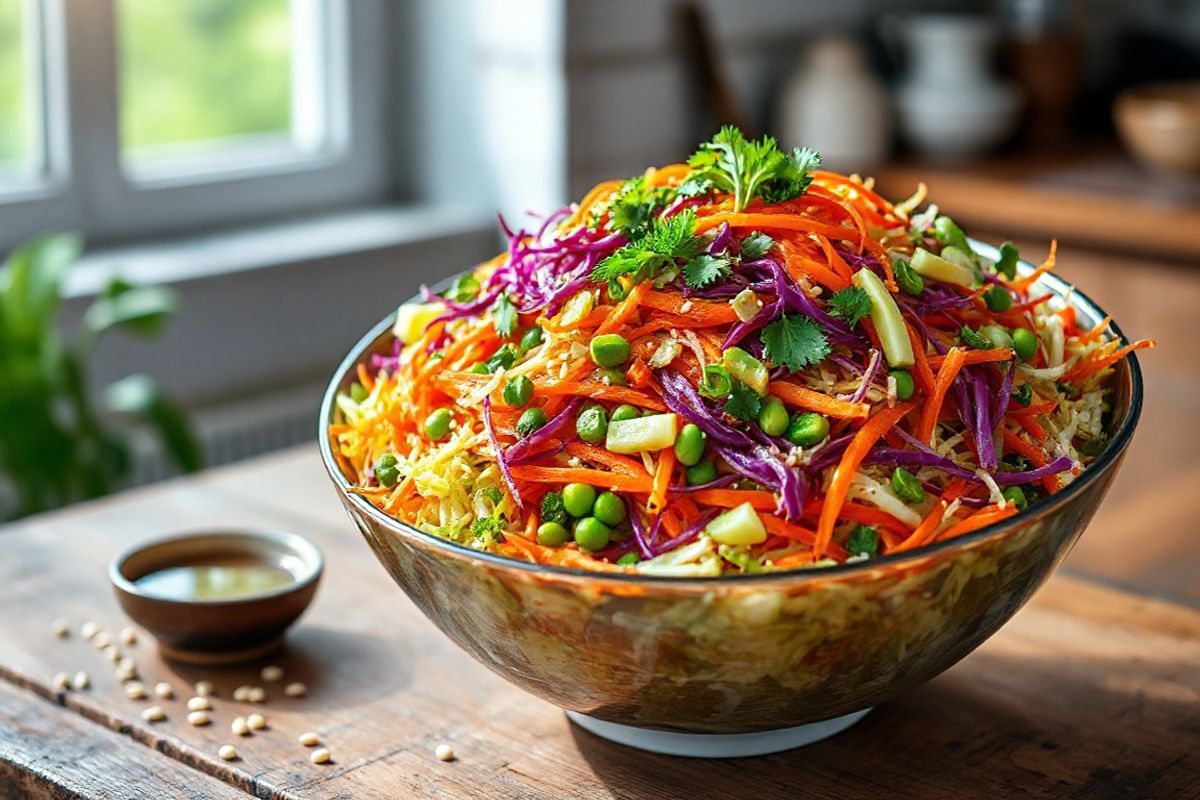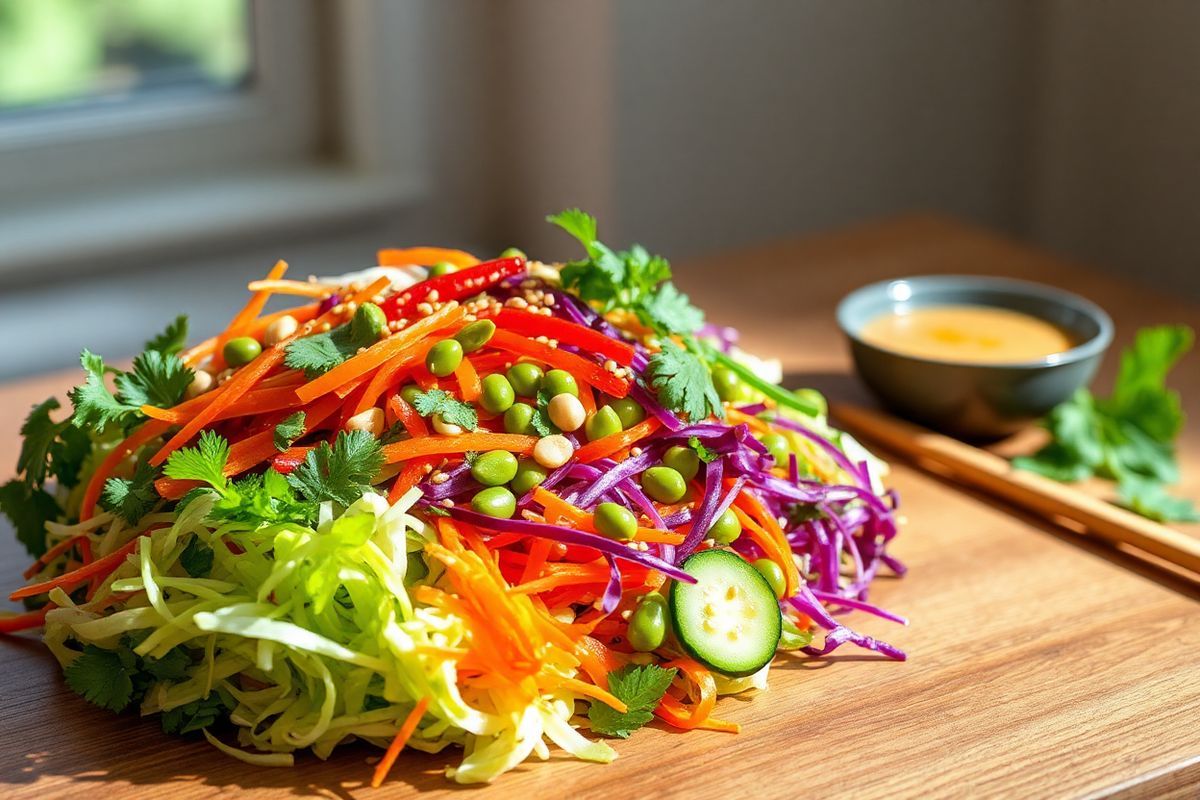Table of Contents
Discover the Fresh Flavors of Asian salad

Asian salads are a delightful fusion of textures, colors, and flavors that captivate the senses and bring a refreshing twist to your meal. They often boast a unique combination of crunchy vegetables, aromatic herbs, and zesty dressings that make them not just a side dish but a star on their own. With the rise of vegetarian and plant-based diets, Asian chopped salads have gained immense popularity among health-conscious individuals and food enthusiasts alike. The beauty of these salads lies not only in their aesthetic appeal but also in the health benefits they offer.
In this article, we will delve deep into the world of Asian chopped salads, uncovering the vibrant ingredients that come together to create a wholesome dish, exploring the myriad health benefits of these salads, and providing simple steps to prepare your very own. We will also highlight various dressings that can elevate your salad experience to new heights. By the end of this article, you will not only be inspired to make your own Asian chopped salad but also understand why it is a fantastic addition to your diet.
A Rainbow of Vegetables: Ingredients for Your Chopped Salad
The cornerstone of any great salad is its ingredients, and Asian chopped salads are no exception. A typical Asian salad features a colorful array of vegetables that not only add to the visual appeal but also provide a range of nutrients essential for a balanced diet. Here are some key ingredients commonly found in Asian chopped salads:
-
Cabbage: Often used as the base, both green and purple cabbages are crunchy, low in calories, and rich in vitamins K and C. They also contain antioxidants that can contribute to overall health.
-
Carrots: Grated or julienned, carrots add a sweet crunch and are an excellent source of beta-carotene, which the body converts into vitamin A. This vitamin is crucial for maintaining healthy vision, skin, and immune function.
-
Bell Peppers: These come in various colors, each offering a different flavor profile. Bell peppers are rich in vitamins A and C, making them a great addition to any salad.
-
Cucumbers: Their refreshing taste and high water content make cucumbers a hydrating ingredient, perfect for adding crunch without adding many calories.
-
Green Onions: Also known as scallions, these provide a mild onion flavor and a pop of color. They are a good source of vitamin K and can enhance the flavor profile of the salad.
-
Fresh Herbs: Herbs like cilantro, mint, and basil not only add flavor but also pack a nutritional punch, offering various vitamins and antioxidants.
-
Nuts and Seeds: Adding a handful of nuts like almonds or seeds such as sesame provides healthy fats and protein, making your salad more filling.
-
Protein Options: For those looking to add some protein, consider including edamame, chickpeas, or tofu, which can turn your salad into a complete meal.
The combination of these ingredients creates a salad that is not only visually appealing but also rich in essential nutrients. The variety of colors signifies the diverse range of vitamins and minerals present, reinforcing the notion that you eat with your eyes first.
Wholesome and Vegetarian: Health Benefits of an Asian Salad
Asian chopped salads are not just delicious; they are also incredibly healthy. The combination of various vegetables provides an array of health benefits, making this dish an excellent choice for anyone looking to improve their diet. Here are some key health benefits associated with consuming Asian salads:
-
Rich in Nutrients: The plethora of vegetables in an Asian salad ensures that you are consuming a wide range of essential vitamins and minerals. For instance, leafy greens are high in vitamins A, C, and K, while carrots provide beta-carotene, which is beneficial for eye health (1).
-
Low in Calories: Most of the ingredients in an Asian salad are low in calories and high in water content, making it an excellent choice for those looking to maintain a healthy weight. Eating low-calorie foods can help you feel full without consuming excess calories.
-
High in Fiber: Vegetables like cabbage and carrots are rich in dietary fiber, which aids in digestion, helps maintain healthy blood sugar levels, and contributes to heart health by lowering cholesterol levels (2). A diet high in fiber has been linked to a reduced risk of various chronic diseases.
-
Antioxidant Properties: Many of the vegetables used in Asian salads are high in antioxidants, which help combat oxidative stress in the body. Antioxidants like vitamins C and E can help reduce inflammation and lower the risk of chronic diseases (3).
-
Heart Health: The inclusion of healthy fats from nuts and seeds, along with fiber-rich vegetables, can contribute to improved heart health. Consuming a diet rich in fruits, vegetables, and healthy fats has been shown to lower cholesterol levels and reduce the risk of heart disease (4).
-
Versatile and Customizable: One of the greatest benefits of Asian salads is their versatility. You can easily customize the ingredients based on seasonal availability or personal preference, ensuring that you always have a fresh and exciting dish on your plate.
Incorporating Asian chopped salads into your diet can lead to improved overall health, making them an excellent addition to any meal plan.
Toss It Up: Simple Steps to Prepare Your Asian Chopped Salad
Preparing a delicious and nutritious Asian chopped salad is a straightforward process that can be completed in just a few simple steps. Here’s how you can create your own vibrant salad at home:
Step 1: Gather Your Ingredients
Start by assembling all the ingredients you wish to include in your salad. Aim for a mix of colors and textures to create a visually appealing dish. Use the following ingredients as a guideline:
- 2 cups shredded cabbage (green or purple)
- 1 cup grated carrots
- 1 cup diced bell peppers (various colors)
- 1 cup sliced cucumbers
- ½ cup chopped fresh herbs (cilantro, mint, or basil)
- ½ cup chopped green onions
- ½ cup edamame or your protein of choice
- ¼ cup nuts or seeds (optional)
Step 2: Prepare the Vegetables
Wash and chop the vegetables as needed. Shredding the cabbage, grating the carrots, and slicing the cucumbers and bell peppers can be done quickly with a sharp knife or a food processor. The goal is to create uniform pieces that are easy to eat and mix.
Step 3: Toss the Ingredients
In a large mixing bowl, combine all the chopped vegetables, herbs, and protein. Use your hands or a large spoon to toss everything together gently. This helps to evenly distribute the ingredients, ensuring that every bite is packed with flavor.
Step 4: Prepare the Dressing
A great salad is often defined by its dressing. For an Asian chopped salad, consider a dressing that combines soy sauce, sesame oil, rice vinegar, honey, and a splash of lime juice. Whisk these ingredients together in a small bowl until well combined.
Step 5: Dress the Salad
Pour the dressing over the salad and toss again to coat all the ingredients evenly. Be sure not to overdress your salad; you can always add more dressing later if needed.
Step 6: Serve and Enjoy
Your Asian chopped salad is now ready to serve! You can enjoy it immediately or let it chill in the refrigerator for about 30 minutes to allow the flavors to meld. This salad can be served as a side dish or as a main course when paired with a protein.
Dressing it Right: Flavorful Sauces to Elevate Your Salad Experience

The dressing you choose can make or break your Asian chopped salad. A well-balanced dressing not only enhances the flavors of the salad but also contributes additional health benefits. Here are some flavorful dressing ideas that complement the fresh ingredients of an Asian salad:
-
Sesame Soy Dressing: Combine ¼ cup soy sauce, 2 tablespoons sesame oil, 1 tablespoon rice vinegar, 1 tablespoon honey, and a sprinkle of sesame seeds. This dressing adds a nutty and savory flavor that pairs perfectly with the crunch of the vegetables.
-
Peanut Dressing: Blend together ¼ cup natural peanut butter, 2 tablespoons soy sauce, 1 tablespoon lime juice, 1 tablespoon honey, and water to thin to desired consistency. This creamy dressing adds richness and protein to your salad.
-
Ginger Lime Vinaigrette: Whisk together ¼ cup olive oil, 2 tablespoons lime juice, 1 tablespoon grated fresh ginger, and a pinch of salt and pepper. This zesty dressing provides a refreshing kick and complements the crispness of the salad.
-
Spicy Sriracha Dressing: For those who enjoy a bit of heat, mix together 3 tablespoons mayonnaise, 1 tablespoon sriracha sauce, 1 tablespoon lime juice, and a touch of honey. This creamy dressing adds a spicy twist to the mix.
-
Miso Dressing: Combine 2 tablespoons miso paste, 2 tablespoons rice vinegar, 1 tablespoon sesame oil, and a bit of honey to taste. Miso adds a unique umami flavor that enhances the overall taste of the salad.
Experimenting with different dressings can elevate your Asian chopped salad and keep your meals exciting. Don’t hesitate to adjust the ingredients of the dressings to suit your taste preferences and dietary needs.
FAQ
What can I add to my Asian chopped salad for more protein?
You can add ingredients such as grilled chicken, shrimp, tofu, edamame, or chickpeas to increase the protein content of your salad.
Can I make Asian chopped salad in advance?
Yes, you can prepare the ingredients in advance and store them separately. Combine them and add dressing just before serving to maintain freshness.
How can I make my Asian salad gluten-free?
To make your Asian salad gluten-free, use tamari instead of soy sauce, and ensure that all other ingredients, such as dressings and toppings, are gluten-free.
Is it okay to use frozen vegetables?
Yes, you can use frozen vegetables if fresh ones are not available. Just make sure to thaw and drain them properly before adding them to your salad.
What are some good toppings for an Asian salad?
Consider adding toppings such as crispy wontons, toasted nuts, or seeds for added texture and flavor.
References
-
National Institutes of Health. (2021). nutritional benefits of cabbage
-
American Heart Association. (2022). The importance of dietary fiber
-
Harvard T.H. Chan School of Public Health. (2023). Antioxidants: In-depth
-
Mayo Clinic. (2022). Heart-healthy diet: 8 steps to prevent heart disease










